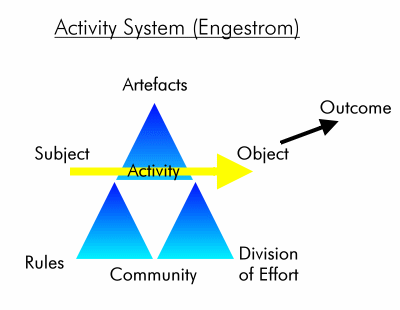Summary: Activity Theory is a framework or descriptive tool for a system. People are socio-culturally embedded actors (not processors or system components). There exists a hierarchical analysis of motivated human action (levels of activity analysis).
Originator: Vygotsky, Leont’ev, Luria, and others starting in the 1920s.
Key terms: Activity, action, operation, object-orientedness, internalization/externalization, mediation, development.
Activity Theory
Activity Theory is more of a descriptive meta-theory or framework than a predictive theory. Considers entire work/activity system (including teams, organizations, etc.) beyond just one actor or user. Accounts for environment, history of the person, culture, role of the artifact, motivations, complexity of real life action, etc[1].
The unit of analysis is motivated activity directed at an object (goal). Includes cultural and technical mediation of human activity, artifacts in use (and not in isolation). Activities consist of goal-directed actions that are conscious. Constituents of activity are not fixed; they can dynamically change.

Engestrom’s model above is useful for understanding how a wide range factors work together to impact an activity. In order to reach an outcome it is necessary to produce certain objects (e.g. experiences, knowledge, and physical products) Human activity is mediated by artefacts (e.g. tools used, documents, recipes, etc.) Activity is also mediated by an organization or community. Also, the community may impose rules that affect activity. The subject works as part of the community to achieve the object. An activity normally also features a division of labour.
Three levels of activity:
- Activity towards an objective (goal) carried out by a community. A result of a motive (need) that may not be conscious social and personal meaning of activity (Answers the Why? question)
- Action towards a specific goal (conscious), carried out by an individual or a group possible goals and subgoals, critical goals (Answers the What? question)
- Operation structure of activity typically automated and not conscious concrete way of executing an action in according with the specific conditions surrounding the goal (Answers the How? question)
Principles:
- Object-orientedness. (this is not to be confused with object-oriented programming) People live in a reality that is objective in a broad sense: the things that constitute this reality have not only the properties that are considered objective according to natural sciences but socially/culturally defined properties as well.
- Internalization/externalization. Distinction between internal and external activities. Internal activities cannot be understood if they are analyzed separately from external activities, because they transform into each other. Internalization is the transformation of external activities into internal ones. Internalization provides a means for people to try potential interactions with reality without performing actual manipulation with real objects (mental simulations, imaginings, considering alternative plans, etc.). Externalization transforms internal activities into external ones. Externalization is often necessary when an internalized action needs to be “repaired,” or scaled. It is also important when a collaboration between several people requires their activities to be performed externally in order to be coordinated.
- Mediation. Activity Theory emphasizes that human activity is mediated by tools in a broad sense. Tools are created and transformed during the development of the activity itself and carry with them a particular culture – historical remains from their development. So, the use of tools is an accumulation and transmission of social knowledge. Tool use influences the nature of external behavior and also the mental functioning of individuals.
- Development. In Activity Theory development is not only an object of study, it is also a general research methodology. The basic research method in Activity Theory is not traditional laboratory experiments but the formative experiment which combines active participation with monitoring of the developmental changes of the study participants. Ethnographic methods that track the history and development of a practice have also become important in recent work.
All four of the above basic principles should be considered as an integrated system, because they are associated with various aspects of the whole activity[2].
For more information, see:
- Yrjö Engeström’s book: Perspectives on Activity Theory (Learning in Doing: Social, Cognitive and Computational Perspectives)
References
- Engeström, Y., Miettinen, R., & Punamäki, R. L. (1999). Perspectives on activity theory. Cambridge University Press.
- Kaptelinin, V., & Nardi, B. A. (2006). Acting with technology: Activity theory and interaction design. MIT press.






